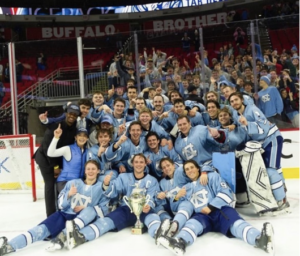By Lindsey Ware
Sit down, college basketball. North Carolina is a hockey state.
The bleachers in the stadium shook with the jumping and roaring of cheers as college students huddled close to one another, bundled in their North Carolina and N.C. State gear. Over 25,000 people showed up to Carter-Finley Stadium on Feb. 20 to watch the schools’ club hockey teams match up in the second-most attended hockey game North Carolina had ever seen.
The Tar Heels fell to their rivals, but the team found a sense of unity and peace in agreeing on two things — the game was surreal, and North Carolina is a hockey state.
UNC club hockey brings together athletes looking to continue playing their sport in a fun environment, but the team’s recent success points towards a promising future for the program and is an example of the surging passion for hockey in North Carolina.
Beating its rivals four of six times this season and racking up accolades wasn’t enough for the Tar Heels. The team is now looking to its future with a strong core group of players returning next year, as well as pondering on the future of hockey for the school and in the state.
“We’d be lying if we said we’re not dreaming of UNC one day getting a (Division 1) team,” team captain Henry Foster said. “Out of pure speculation and optimism, in the next 15 years, we’re going to be a D-1 program.”
Cigar-smoking head coach drives team growth & success
North Carolina is tied with Duke for the most years in ACC Division II hockey — 26. This year, UNC experienced its most successful season yet, racking up titles such as State Champions, ACCHL Division Champions, Governor’s Cup Champions, and Regional Finalists, as well as going 10-2 against in-state opponents.
The Tar Heel team is directed by head coach Jeff Volkman. Volkman can often be found smoking a cigar in the locker room after a big win or cracking open a beer on the bus with his of-age players, but that doesn’t mean he doesn’t take the sport seriously. In his ninth season with UNC hockey this year, Volkman was named the ACHA Southeast Region Coach of the Year.
Volkman was born in Minnesota, where kids are basically born on skates. Volkman began skating at the age of four and went on to play semi-pro hockey in Germany. He’s now been coaching for 25 years, including nearly a decade at UNC. As head coach, he’s built up the program to include a full staff and a more competitive schedule.
Volkman reflected on the big step forward for Tar Heel hockey this season, one characterized by the high crowd attendance that was highlighted at the Carter-Finley outdoor game. As head coach, he values the positive energy in the locker room and the lack of ego on the team. Volkman attributes this culture to the team’s success this season and has high hopes for what is to come.
“There’s going to be more pressure each year on the players and the staff to succeed and keep moving forward,” Volkman said. “We have high expectations, but we make them realistic and keep moving forward.”

“As soon as you put on a hockey jersey, we all speak the same language”
The Tar Heel team is aided by players from a variety of backgrounds, from a first-year who was born in hockey-crazed Toronto to a 39-year-old Afghanistan war veteran continuing his hockey career as the team’s goalie.
Team captain Foster was tempted to play hockey in college after a childhood during which nearly every player he grew up with had aspirations of playing in college. Foster wanted to focus on his long-term future, the next 40 years instead of the next four, he said. When he got into UNC, it was too good of an offer to pass up.
Foster soon discovered UNC club hockey, which allowed him to continue his athletic career at a top public university. Since then, the junior was named the 2021-22 team MVP and currently serves as team captain.
“It’s been some of the most fun hockey I’ve played my whole life,” Foster said. “As soon as you put on a hockey jersey, we all speak the same language.”
The diverse backgrounds of the UNC club hockey team are evident in Afghanistan war veteran Joel Hughes. At 39 years old, Hughes is the oldest member of the team. He is working towards an exercise science degree at the University as he prepares to officially retire from the Army in August.
After growing up playing hockey in New Hampshire, Hughes enrolled in the Army directly after high school graduation. He has continued his hockey career with a nonprofit team at his military base at Fort Bragg and is now at UNC as the team goalie. Even though his locker room playlist varies significantly from that of his younger teammates, Hughes has had a smooth transition to hockey at the college level.

On the other end of the extreme is 19-year-old Patrick O’Shaughnessy, who is a first-year at UNC. O’Shaughnessy spent the first eight years of his life in Toronto, Canada before relocating to Greensboro, N.C. He found it hard to keep playing hockey because of a lack of popularity and tough competition in the South but has found that sense of competition again at UNC.
The young forward was shocked to join a team that had players up to 20 years older than him but was welcomed with open arms.
Like all other UNC club hockey first-years, O’Shaughnessy had to participate in freshman karaoke. On the bus ride back to Chapel Hill after the first weekend away of the season, first-years take their turn in the karaoke tradition. Taylor Swift and country are commonplace in karaoke, with a few rap songs mixed in.
Apart from karaoke antics, in his first year with UNC club hockey, O’Shaughnessy has recognized the future of the sport in the state where he has spent the last decade.
“Since I’ve been living in North Carolina, the Canes, and hockey in general have grown a lot,” O’Shaughnessy said. “We definitely saw that this year.”
Tense rivalry & the hockey state
The Carolina Hurricanes are North Carolina’s NHL team. The Canes currently lead the Metropolitan Division after winning the division last season and winning the Central Division the season before that. The team ranks second in the league in attendance and attracted nearly 57,000 people to its outdoor Stadium Series game at Carter-Finley this February.
North Carolinians’ dedication to attending hockey games is translating to college hockey. The Tar Heel and Wolfpack hockey rivalry is tense and was on its biggest stage ever in the stadium matchup.

UNC entered the season determined to rule over rival N.C. State, who is the notoriously better team and was a 2021 ACHA Division II National Qualifier. Ahead of the first rivalry game of the season, Volkman came into the locker room, and his players eagerly prepared to listen to his insight on approaches to the matchup. Instead, his speech was short. “I hate these guys,” Volkman said about N.C. State’s Ice Pack. “Let’s go.”
A former player shared Volkman’s sentiment in a text to Foster. “Please do it,” he pleaded. “I’m so tired of watching these guys.” North Carolina honed in on its hatred to defeat N.C. State 5-3 in the first rivalry matchup of the season and went on to beat the Ice Pack at the Governor’s Cup for the first Governor’s Cup win in program history.

The two teams taunt each other on social media with tweets saying things like “bye-bye wolfies” and “Tarhole goal,” but this season, UNC got the last laugh. The Tar Heels clinched the series with a 6-3 win over the Wolfpack in the first round of the ACHA Division II regionals.
Whether they’re chasing the competitive nature of Canadian hockey or looking to stretch out their playing career, UNC hockey players participate in the club to keep playing their sport while working for a degree. But, this year, the team’s success brought the club sport to a new level.
After a record-breaking season that demonstrated North Carolinians’ devotion to hockey, the diverse UNC club hockey team will look forward with hopes of a Division I future.
Edited by Harrison Clark and Noah Monroe



